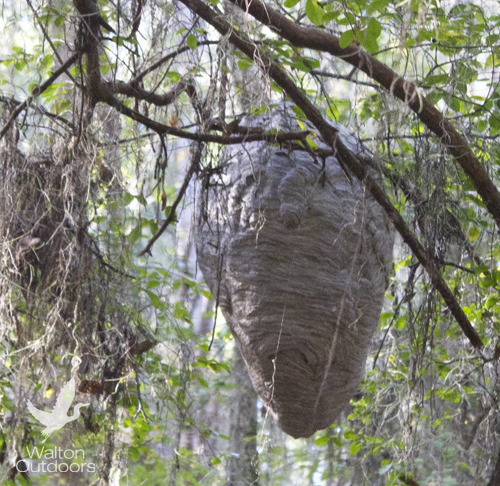
Nest to be preserved for exhibit
Careful where you walk near the pavilions at Eden Gardens State Park. A very large and active baldfaced hornet nest hangs precariously from a live oak tree. Discovered by one of the park volunteers recently, the nest is more than 3 ft. in length and approximately 12 inches in diameter near the top.
“We plan to preserve it once the wasps die off,” said Dan Burton, park service specialist.
About bald faced hornets
The baldfaced “hornet,” (Dolichovespula maculata) is actually not a true hornet, which are defined as wasps of the genus Vespa. (In fact the genera Dolichovespula and Vespula are, at least in the US, referred to as yellow jackets.) Like true hornets, D. maculata makes an unconcealed paper nest in trees, and this hornet-like trait, together with its black and white coloration and atypically large size probably inspired its common name. The baldfaced hornet is a social wasp native to North America. This species is common and widespread in every Canadian province and US state.
Dolichovespula maculata workers are impressive, imposing wasps that grow to about 2 cm long and eat flower nectar, pollen, fruit juice, sap and insects (mostly small insects, but they do attack insects as large as a cicada or preying mantis). They are helpful pollinators, and also helpful in removing insects that harm ornamental plants. Baldfaced hornets occasionally scavenge dead meat for protein, although they usually catch their prey live. Grant (1959) documents a rare baldfaced hornet attack of an adult hummingbird.
Each spring, new queens start a new nest by building a few cells and laying eggs in them. New fertile queens are the only survivors of colonies from the previous year; these are females that were fertilized by drones in the fall and overwintered under ground or in hollow tree trunks. Once their first batch of eggs hatch, these become new workers (unfertilized females) that continue to build the nest from a paper-like substance they produce by chewing up wood and mixing it with their starchy saliva. Baldfaced hornets are more aggressively protective of their nests than other yellow jackets and will sting potential threats multiple times. The nests often harbor associated species, such as ichneumon wasps and cockroaches. Nest size is usually about 400 individuals. By winter the nests are abandoned as all the inhabitants die (or, in the case of new queens, move on to hibernate), and the nests are not reused. Nests, which can be up to three feet long, commonly adorn nature centers, and are easily preserved as decoration.
Information courtesy eol.com.
